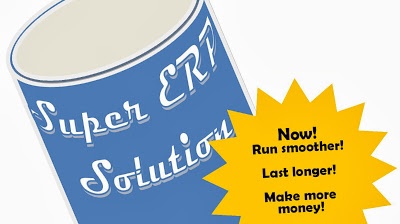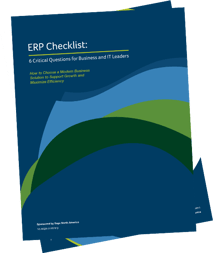
In Part 1 of this article, What You Need to Know Before Buying ERP Software – Part 1 of 2, we talked about the inherent flaws in the ERP (and related technologies) industry whereby both the value-added resellers and their customers come to believe that new technologies are like an engine additive for your car. Without much further thought, both buyer and seller seem to come to the same unfounded conclusion:
“Yessiree!
Step right up!Just pour our latest and greatest ‘Super ERP Solution’ into your company and you can rest assured that your company will run smoother, last longer and make more money!!”
We believe that there are lots of ways that you and your company can begin running smoother, and making more money—ways that do not involve replacing your ERP system. In fact, even though we sell technology, we think there may be dozens of ways your company can start making more money almost immediately without any further investment of cash at all.
Here are a few ideas.
Moving Toward “inherent simplicity”
In many of the companies with which we work, we find that there are times and situations in which they are attempting to apply automation and technology where the structure of the technology actually makes certain tasks more complex and more time consuming than they need to be.
In such cases, we frequently suggest that they just stop using technology and return to simpler manual methods. Sometimes simply passing work from one workstation to another is a more effective way to synchronize the flow of production than all the needless complexities of APS (advanced planning and scheduling).
Other times we might find that a simple three-bin kanban approach to replenishment—either internal or external—may be simpler and more effective than trying to find the just the right settings for achieving effective results with MRP (material requirements planning).
On occasion, we find that making simple, no-cost changes to business forms makes life simpler and the work flow more effective for everyone involved.
Leverage Existing ERP Functionality
It is not unusual at all for us to come into a new client’s facilities or come back to an existing client’s offices and discover that they are not making use of capabilities for which they have already made the investment in technologies.
There is so much to absorb during the relatively short training cycle on a new ERP system that it is not infrequent for users to not absorb functional concepts that are not immediately implemented. As a result, by the time the users have mastered the essentials for getting their new ERP system operational, they have already forgotten about additional functionality that could be leveraged to make day-to-day activities more effective as their business or business environment changes.
Redesign Key Business Processes
Far too many firms try to minimize the changes that occur during the deployment of a new ERP system or other technologies. Rather than taking advantage of the change in technologies as a launching pad for improving business processes they, instead, try to hold onto existing business process and try to make them work—as well as possible—under the constraints and demands of the technologies.
We later find that these companies can harvest new capacity-increasing, profit-enhancing benefits by simply creating better alignment between their business processes and the technologies that now underlie the processes.
Implement New, High-value KPIs Based on System Thinking
Sometimes companies are bogged down in cost-world thinking and KPIs that actually pit one department or functional unit against another. We work with these companies to help them gain a system view, applying system thinking, to create new KPIs that unify actions across the entire organization—the entire system—thus driving new profits to the bottom-line.
Get Started on a POOGI
It is not unusual at all for us to find that many of the companies we visit have no POOGI—no Process Of On-Going Improvement—in place. Their approach, usually quite unintentionally, is one of fire-fighting with occasional flashes of insight in the vain hope of at least staying competitive.
They do not have the tools, and generally do not believe that they have the time, to spend on POOGI activities or thinking.
Getting these executives and managers to see that they do not have time NOT to start thinking in a POOGI way breaths new life and profits into sometimes stagnant or otherwise struggling firms.
Summary
In short, we find time after time that companies that are presently considering new technology investments can frequently reap huge benefits by taking actions that have nothing to do with buying or implementing new software or systems.
And, if they actually do need some new technologies to support increased Throughput, or to help them hold the line on operating expenses while sustaining significant increases in Throughput, the non-technological changes (sampled above) can frequently help them liberate the cash-flow for the necessary investments in new technologies.
Part 2 deals with things that can be done to improve performance using the investments already made in IT. This, again, is a “keeping them in the family” concept. A company that is moving, for example, off of Sage 500 ERP to Sage ERP X3 because it has truly exhausted the capabilities of Sage 500 ERP, and can substantiate the ROI to be reaped from the benefits of moving to Sage ERP X3, is going to be a much happier “family member” than one that is totally frustrated with their present ERP product, but also has never really leveraged all that the software could be doing for them in support of improving profitability.
These articles represent two aspects of the same subject—one looking at it from the East, while the other views it from the West, so to speak.
Please let us hear what you are thinking on this topic. Leave your comments here, or feel free to contact us directly.
[feature_box style="2" only_advanced="There are no title options for the choosen style" alignment="center"]
 While You're Here ...
While You're Here ...
Grab a copy of How to Choose A New ERP System.
This free guide provides IT and business leaders with a critical checklist for choosing an ERP system that supports growth and maximizes efficiency.
Download Free Guide [/feature_box]



